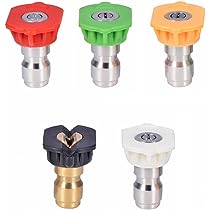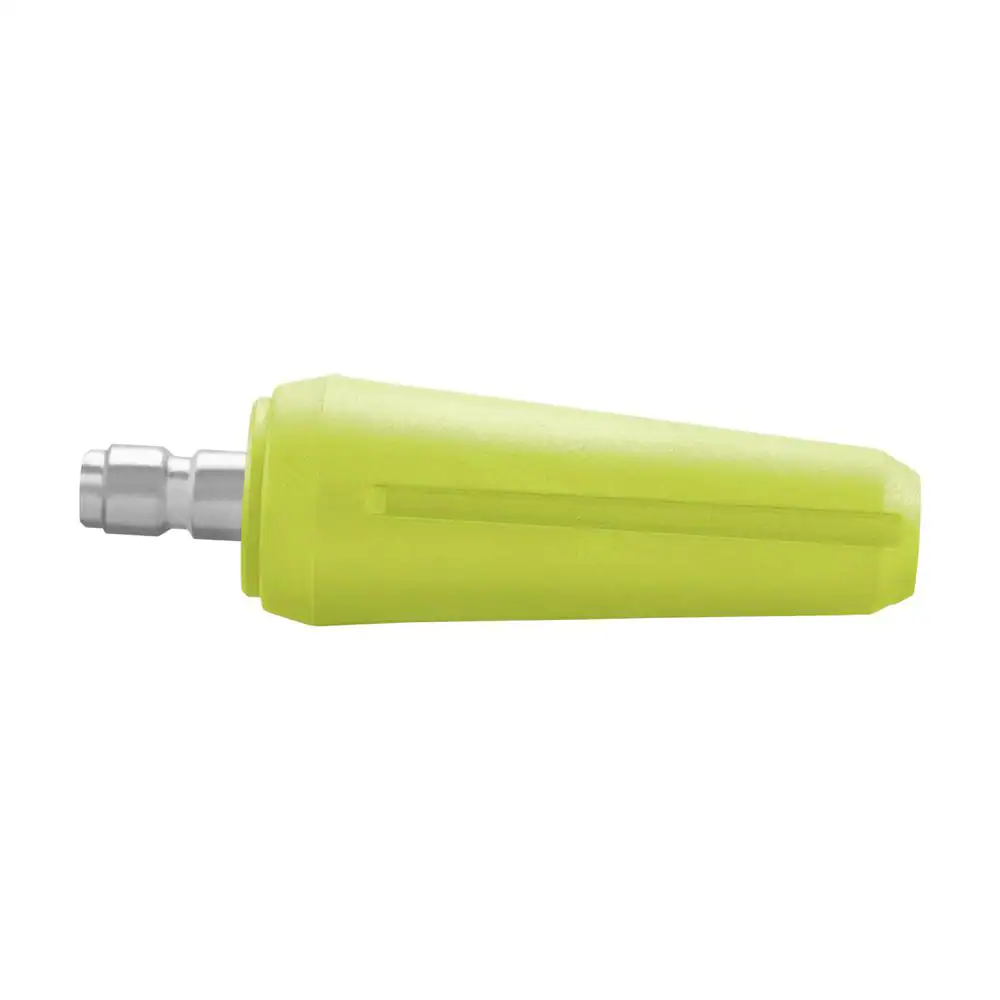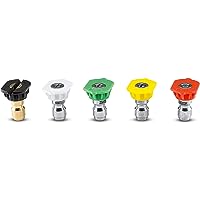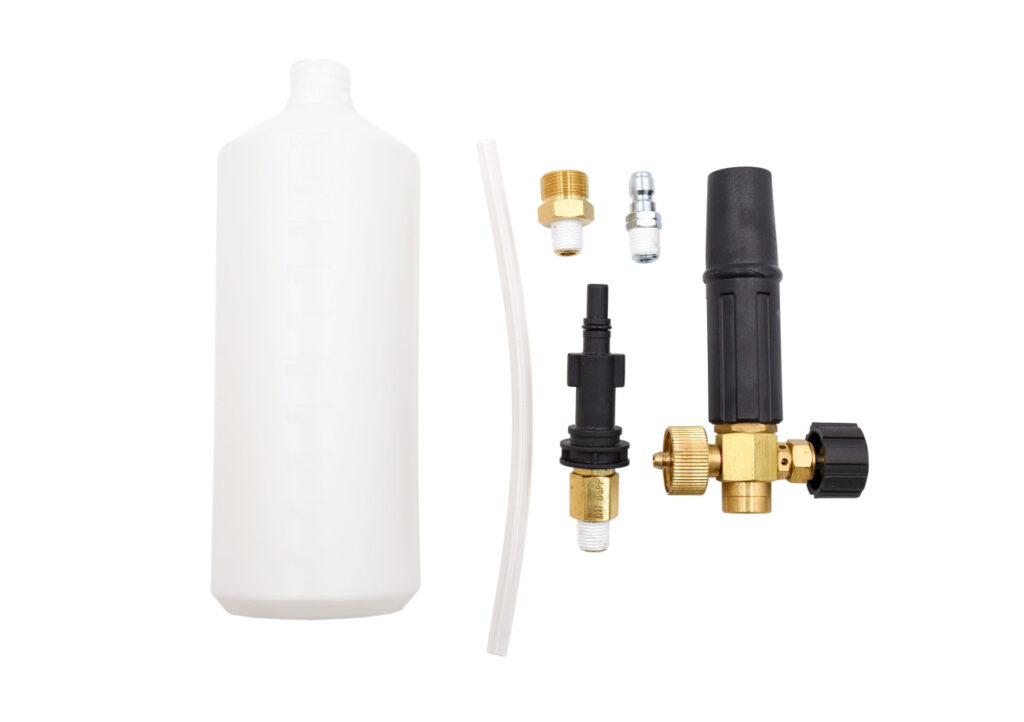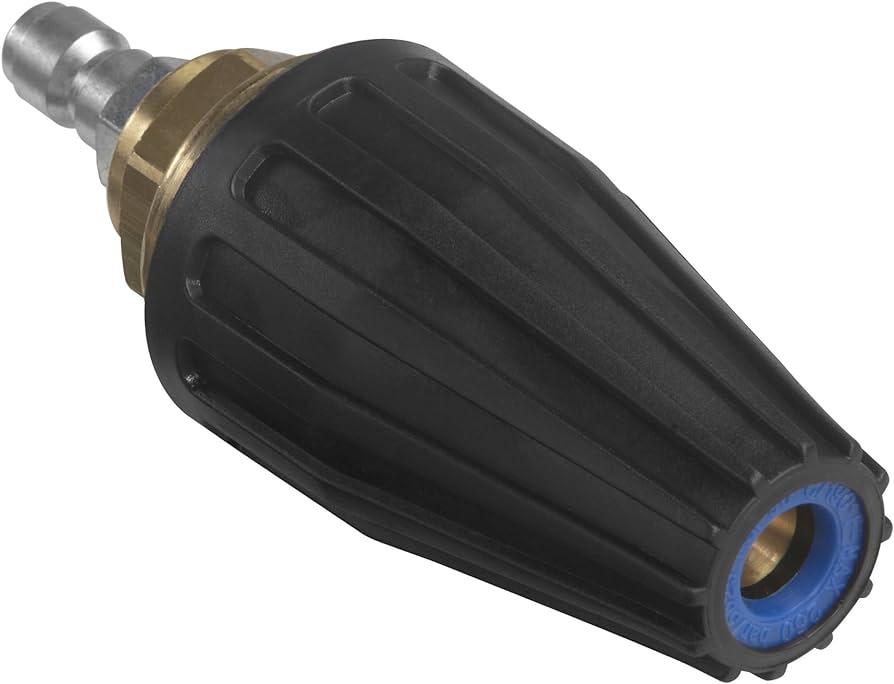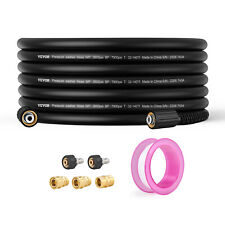Introduction to Pressure Washer Nozzles
Pressure washers are powerful tools that can make your cleaning tasks significantly more efficient and effective. However, the secret to harnessing their true potential lies in something as seemingly simple as the pressure washer nozzles. These small, often overlooked attachments play a crucial role in determining the performance and safety of your pressure washer.
Pressure washer nozzles are the gatekeepers of the force and precision that your pressure washer provides. They control the spray pattern, pressure intensity, and the overall effectiveness of the cleaning process. In essence, they are the key to achieving optimal results in various cleaning tasks. Whether you’re tackling stubborn grime on your driveway, washing your car, or even doing some heavy-duty industrial cleaning, the choice of the right pressure washer nozzle can be the difference between a job well done and a job that leaves you frustrated and dissatisfied.
Think of pressure washer nozzles as the specialized tools in your cleaning arsenal, each designed to serve a specific purpose. The nozzle you select determines the pressure and angle at which the water is delivered, and this has a direct impact on your ability to remove dirt, stains, and grime effectively.
Best Pressure Washer Nozzles for Your Cleaning Needs
When it comes to selecting the best pressure washer nozzle for your cleaning tasks, you’ll find several reputable companies and models on the market. Below, we’ve highlighted a few of the top options with their respective specifications to help you make an informed choice.
1. Mosmatic HP Nozzle (Part #29.027)
- Company: Mosmatic
- Model: HP Nozzle
- Specifications:
- Material: Stainless steel
- Spray Angles: 0-degree, 15-degree, 25-degree, and 40-degree
- Flow Rate: Varies with the pressure washer model
- Quick-Connect: Yes
The Mosmatic HP Nozzle is known for its durable stainless steel construction and a wide range of available spray angles. The 0-degree nozzle provides a powerful, concentrated stream for tough cleaning jobs, while the 40-degree nozzle offers a gentler, wider spray for more delicate surfaces. The quick-connect feature ensures easy attachment and swapping of nozzles, saving you time and effort.
2. Simpson 80146 3700 PSI Quick Connect Spray Nozzles
- Company: Simpson
- Model: 80146
- Specifications:
- Material: Stainless steel
- Spray Angles: 0-degree, 15-degree, 25-degree, and 40-degree
- Flow Rate: 3.5 GPM
- Quick-Connect: Yes
The Simpson 80146 Quick Connect Spray Nozzles are compatible with pressure washers up to 3700 PSI. They are built to last with stainless steel construction, ensuring durability and resistance to corrosion. With a flow rate of 3.5 GPM, these nozzles offer great versatility for a range of cleaning tasks, from stripping paint to washing vehicles.
3. Twinkle Star Pressure Washer Spray Nozzle Tips Set
- Company: Twinkle Star
- Model: Pressure Washer Spray Nozzle Tips Set
- Specifications:
- Material: Brass and stainless steel
- Spray Angles: 0-degree, 15-degree, 25-degree, 40-degree, soap nozzle
- Flow Rate: Varies with the pressure washer model
- Quick-Connect: Yes
The Twinkle Star Pressure Washer Spray Nozzle Tips Set is a versatile option, offering a variety of spray angles to tackle different cleaning jobs. With both brass and stainless steel construction, these nozzles are built to withstand the rigors of pressure washing. The inclusion of a soap nozzle is especially handy for applying detergent when needed.
4. Ryobi 3,300 PSI Pressure Washer Turbo Nozzle
- Company: Ryobi
- Model: 3,300 PSI Pressure Washer Turbo Nozzle
- Specifications:
- Material: Brass
- Spray Angles: Turbo (rotating)
- Flow Rate: Varies with the pressure washer model
- Quick-Connect: Yes
The Ryobi 3,300 PSI Pressure Washer Turbo Nozzle stands out with its unique turbo design. This rotating nozzle creates a powerful, oscillating water jet, effectively increasing the cleaning efficiency. The brass construction ensures longevity and durability, making it a great choice for tough cleaning tasks.
5. Greenworks 5201402 Turbo Nozzle for Electric Pressure Washers
- Company: Greenworks
- Model: 5201402 Turbo Nozzle
- Specifications:
- Material: Plastic with metal components
- Spray Angles: Turbo (rotating)
- Flow Rate: Compatible with Greenworks electric pressure washers
- Quick-Connect: Yes
The Greenworks 5201402 Turbo Nozzle is designed for use with Greenworks electric pressure washers. It features a rotating spray pattern that enhances cleaning power, making it ideal for removing stubborn stains and dirt from various surfaces. The quick-connect feature ensures easy attachment and compatibility with Greenworks pressure washers.
6. Sun Joe SPX-AGHA Universal Brass Pressure Washer Garden Hose Adapter
- Company: Sun Joe
- Model: SPX-AGHA Garden Hose Adapter
- Specifications:
- Material: Brass
- Compatibility: Universal fit for most pressure washers
- Quick-Connect: No
The Sun Joe SPX-AGHA Garden Hose Adapter is a handy accessory that allows you to connect your pressure washer to a standard garden hose. Made from durable brass, it ensures a secure and leak-free connection, enabling you to easily switch between pressure washing and other outdoor tasks.
7. Karcher 5-Piece Quick-Connect Spray Nozzle Set
- Company: Karcher
- Model: 5-Piece Quick-Connect Spray Nozzle Set
- Specifications:
- Material: Plastic with stainless steel components
- Spray Angles: 0-degree, 15-degree, 25-degree, 40-degree, soap nozzle
- Flow Rate: Varies with the pressure washer model
- Quick-Connect: Yes
The Karcher 5-Piece Quick-Connect Spray Nozzle Set provides a range of spray angles, including a soap nozzle, making it versatile for a variety of cleaning tasks. Designed for Karcher pressure washers, these nozzles ensure consistent performance and a quick, secure connection.
8. AR Blue Clean AR909104K Foam Cannon with 34 oz. Detergent Bottle
- Company: AR Blue Clean
- Model: AR909104K Foam Cannon
- Specifications:
- Material: Brass and plastic
- Compatibility: Universal fit for most pressure washers
- Quick-Connect: Yes
The AR Blue Clean AR909104K Foam Cannon is an excellent choice for those who want to add a layer of foam to their pressure washing routine. This accessory includes a 34 oz. detergent bottle and creates a thick, clinging foam that enhances cleaning and surface penetration. It’s designed for universal compatibility with most pressure washers.
9. Briggs & Stratton 6196 Quick-Connect 5-in-1 Spray Nozzle for Gas Pressure Washers
- Company: Briggs & Stratton
- Model: 6196 5-in-1 Spray Nozzle
- Specifications:
- Material: Brass
- Spray Angles: 0-degree, 15-degree, 25-degree, 40-degree, soap nozzle
- Flow Rate: Varies with the pressure washer model
- Quick-Connect: Yes
The Briggs & Stratton 6196 5-in-1 Spray Nozzle is a versatile option that offers five different spray patterns, including a soap nozzle. It’s compatible with most gas pressure washers and features durable brass construction, ensuring reliable and efficient cleaning performance.
10. Realm C05 Quick-Connect Foam Cannon for Pressure Washers
- Company: Realm
- Model: C05 Quick-Connect Foam Cannon
- Specifications:
- Material: Plastic with stainless steel components
- Compatibility: Universal fit for most pressure washers
- Quick-Connect: Yes
The Realm C05 Quick-Connect Foam Cannon is a cost-effective choice for adding a foam layer to your pressure washing routine. With a universal fit for most pressure washers and a quick-connect feature, it’s easy to use and enhances the effectiveness of your cleaning tasks. The plastic and stainless steel construction ensures durability.
Comparison Chart
| No. | Company | Model | Material | Spray Angles | Flow Rate | Quick-Connect |
|---|---|---|---|---|---|---|
| 1 | Mosmatic | HP Nozzle | Stainless Steel | 0°, 15°, 25°, 40° | Varies with pressure washer | Yes |
| 2 | Simpson | 80146 Turbo Nozzle | Stainless Steel | 0°, 15°, 25°, 40° | 3.5 GPM | Yes |
| 3 | Twinkle Star | Spray Nozzle Tips Set | Brass and Stainless Steel | 0°, 15°, 25°, 40°, Soap | Varies with pressure washer | Yes |
| 4 | Ryobi | 3,300 PSI Turbo Nozzle | Brass | Turbo (Rotating) | Varies with pressure washer | Yes |
| 5 | Greenworks | 5201402 Turbo Nozzle | Plastic with Metal | Turbo (Rotating) | Compatible with Greenworks electric pressure washers | Yes |
| 6 | Sun Joe | SPX-AGHA Garden Hose Adapter | Brass | Universal Fit | N/A | No |
| 7 | Karcher | 5-Piece Quick-Connect Spray Nozzle Set | Plastic with Stainless Steel | 0°, 15°, 25°, 40°, Soap | Varies with pressure washer | Yes |
| 8 | AR Blue Clean | AR909104K Foam Cannon | Brass and Plastic | Universal Fit | N/A | Yes |
| 9 | Briggs & Stratton | 6196 5-in-1 Spray Nozzle | Brass | 0°, 15°, 25°, 40°, Soap | Varies with pressure washer | Yes |
| 10 | Realm | C05 Quick-Connect Foam Cannon | Plastic with Stainless Steel | Universal Fit | N/A | Yes |
These are just a few of the many pressure washer nozzle options available on the market. When selecting the best nozzle for your needs, consider the material, spray angles, and flow rate to ensure you’re well-equipped to tackle your specific cleaning projects. Remember to check the compatibility with your pressure washer model and always follow safety guidelines when using these nozzles to prevent damage to surfaces and ensure your safety during operation.
Understanding Pressure Washer Nozzles
Explanation of how pressure washer nozzles work:
Pressure washer nozzles play a critical role in the operation of your pressure washer by controlling the direction and force of the water stream. They work on a simple yet effective principle: as pressurized water flows through the nozzle, it is forced through a small orifice. This restriction in the orifice size increases the water’s velocity, resulting in a high-pressure, focused spray. The nozzle’s design directs the water into a specific pattern, which varies depending on the type of nozzle.
When you pull the trigger on your pressure washer wand, water flows through the hose and into the nozzle. The nozzle’s internal design determines the angle and shape of the spray pattern, as well as the intensity of the water stream. It’s the combination of pressure, flow rate, and nozzle type that determines the cleaning power of your pressure washer.
Different types of pressure washer nozzles:
There are various types of pressure washer nozzles, each designed for specific cleaning tasks. Understanding the different nozzle types and their applications is crucial for achieving the best results:
-
- 0-Degree Nozzle: Also known as the red nozzle, this nozzle delivers a concentrated, high-pressure stream in a zero-degree angle. It’s ideal for removing tough stains, graffiti, or stripping paint. However, it should be used with caution, as the concentrated stream can damage surfaces or cause injury if not handled properly.
- 15-Degree Nozzle: The yellow nozzle produces a 15-degree fan-shaped spray pattern. It’s suitable for intense cleaning tasks like removing mold, mildew, and grease. This nozzle provides a balance between power and coverage.
- 25-Degree Nozzle: The green nozzle offers a 25-degree fan pattern. It’s a versatile choice for general-purpose cleaning tasks, such as washing vehicles, decks, and sidewalks. It strikes a balance between power and surface area coverage.
- 40-Degree Nozzle: The white nozzle produces a wide 40-degree fan pattern, making it ideal for delicate surfaces and applying detergents or soaps. It provides a gentle but thorough cleaning action.
- Soap Nozzle: The black nozzle is designed for applying detergents or soaps during the cleaning process. It has a wide spray pattern and low pressure, allowing the detergent to mix effectively with the water for thorough cleaning.
Importance of nozzle size and spray angle:
The nozzle size and spray angle are critical factors in determining the effectiveness and safety of your pressure washer. Here’s why they matter:
-
- Cleaning Efficiency: Nozzle size directly affects the flow rate and pressure of the water stream. Using the right size nozzle for your specific cleaning task ensures efficient dirt and grime removal.
- Surface Safety: Selecting the appropriate spray angle is crucial for preventing damage to surfaces. A narrow 0-degree nozzle can cut into surfaces, while wider angles disperse the pressure, reducing the risk of damage.
- Versatility: By having a variety of nozzle types, you can switch between them to adapt to different cleaning tasks, achieving the best results for each.
- User Safety: Using the correct nozzle size and spray angle reduces the risk of accidents and injuries, as it helps control the pressure and direction of the water stream.
Benefits of Using the Best Pressure Washer Nozzle:
Improved Cleaning Efficiency and Results:
When you use the right pressure washer nozzle for a specific cleaning task, you’ll notice a significant improvement in your cleaning efficiency and the quality of the results. Here’s how:
- Targeted Cleaning: Nozzles with different spray angles and sizes allow you to tailor the water spray pattern to the surface you are cleaning. For example, a 0-degree nozzle provides a concentrated and powerful stream, perfect for removing stubborn stains or stripping paint, while a 40-degree nozzle offers a wider and gentler spray ideal for cleaning delicate surfaces like your car or windows.
- Faster Cleaning: The correct nozzle helps you clean surfaces in less time. With the right pressure and spray pattern, you can remove dirt, grime, and even graffiti more efficiently, saving you both time and effort.
- Reduced Water and Detergent Usage: By using the right nozzle, you can achieve effective cleaning with less water and detergent. This not only saves resources but also reduces your environmental impact.
Enhanced Safety for Both Users and Surfaces:
Using the best pressure washer nozzle is not just about efficiency; it’s also about safety. Here’s how it enhances safety:
- Reduced Risk of Damage: A nozzle with the correct spray pattern and pressure prevents accidental damage to surfaces. For example, a high-pressure nozzle on a delicate surface can cause scratches, while a wide-angle nozzle might not effectively remove tough stains.
- Minimized Injury Risk: The right nozzle minimizes the risk of injury to the user. High-pressure water jets can be dangerous if not handled properly, so using the right nozzle for the job ensures that the water pressure is appropriate, reducing the chance of accidents.
- Protecting Nearby Objects: The correct nozzle helps prevent accidental damage to objects and plants near the cleaning area by allowing you to control the spray pattern and intensity.
Longer Equipment Lifespan and Reduced Maintenance:
The choice of nozzle also affects the longevity of your pressure washer. Here are the benefits in terms of equipment lifespan and maintenance:
- Reduced Wear and Tear: When you use the right nozzle, your pressure washer operates more efficiently, putting less strain on the motor and pump. This reduces wear and tear on the machine, leading to a longer lifespan and less frequent repairs.
- Lower Maintenance Costs: A pressure washer that is used with the correct nozzle experiences fewer breakdowns and requires less maintenance, saving you money in the long run.
- Improved Durability: High-pressure nozzles can wear out over time, but choosing the right nozzle for each task can extend the lifespan of your nozzles themselves, reducing the need for replacements.
Tips for Proper Nozzle Maintenance:
Cleaning and Unclogging Nozzles:
Proper nozzle maintenance is essential to ensure they continue to work effectively. Here are some tips for cleaning and unclogging nozzles:
- Regular Cleaning: After each use, clean the nozzle by removing any dirt or debris that may have accumulated. Use a small brush or a pin to dislodge any particles blocking the nozzle orifice.
- Soaking in Vinegar: If the nozzle is clogged with mineral deposits, soak it in vinegar for a few hours or overnight. This will help dissolve the minerals and clear the nozzle.
- Air Compressor: If your nozzle is severely clogged, you can use an air compressor to blow out any blockages. Be cautious when doing this to avoid damaging the nozzle.
Inspecting for Wear and Tear:
Regular inspection helps identify and address nozzle issues before they become major problems. Here’s how to inspect your nozzles:
- Check for Cracks or Damage: Inspect the nozzle body for any cracks or signs of damage. A damaged nozzle may not perform as intended and could be a safety hazard.
- Examine the Orifice: Look at the nozzle orifice for wear and tear. If it’s worn or enlarged, it may be time to replace the nozzle.
- Ensure Proper Connection: Make sure the nozzle is securely attached to the pressure washer wand to prevent any leaks or inefficiencies.
Storing Nozzles Correctly:
Proper storage is vital to keep your nozzles in good condition. Here are some storage tips:
- Clean Before Storage: Before storing your nozzles, clean them thoroughly to remove any dirt, grime, or detergents.
- Store in a Dry Place: Store your nozzles in a dry, cool place to prevent corrosion and damage.
- Use Protective Covers: Consider using protective covers to shield your nozzles from dust and debris when not in use.
By following these maintenance tips, you can ensure that your pressure washer nozzles remain in top-notch condition and continue to deliver excellent results during your cleaning tasks.
Safety Precautions When Using Pressure Washer Nozzles
Importance of Proper Safety Gear:
When operating a pressure washer, ensuring the safety of both the user and the surrounding environment is paramount. Proper safety gear includes items such as safety glasses, hearing protection, and gloves. Safety glasses shield your eyes from potential debris, water splashes, or detergent splatter, reducing the risk of eye injuries. Wearing hearing protection is crucial, especially if you’re working with high-pressure models, as they can generate a significant amount of noise that may harm your hearing. Additionally, using gloves will protect your hands from the force of the spray and potential chemical exposure if you’re using detergents.
Preventing Injury and Damage to Surfaces:
Pressure washers are powerful tools that, if not used with caution, can cause injuries and damage to surfaces. To prevent injury, never aim the pressure washer at yourself, other people, or pets. It’s essential to keep a safe distance from the nozzle’s spray, as high-pressure water can cause severe harm. Also, avoid pointing the nozzle at electrical outlets, appliances, or power sources to prevent electrical accidents. To prevent damage to surfaces, always start with the widest spray pattern nozzle and increase the pressure gradually. Never use a zero-degree nozzle on surfaces like wood, paint, or delicate materials, as it can cause irreparable damage. Be mindful of the pressure setting and maintain a consistent distance between the nozzle and the surface being cleaned.
Avoiding Common Mistakes:
One common mistake to avoid is holding the nozzle too close to the surface. This can cause etching, gouging, or chipping of materials like concrete, wood, and even metal. Always maintain an appropriate distance from the surface you’re cleaning and adjust it as needed based on the task. Another mistake is neglecting to secure the hose properly. A high-pressure hose can whip around unpredictably if not secured, potentially causing injury. Make sure the hose is free from kinks and loops that could impede water flow and lead to pressure fluctuations, which may damage the pump over time. Additionally, never leave the pressure washer unattended while it’s running, especially if you have small children or pets in the area. Always turn off the machine and release pressure when taking a break or switching nozzles to ensure safety.
Best Practices for Pressure Washer Nozzle Usage
Techniques for Various Cleaning Tasks:
The best practices for pressure washer nozzle usage vary depending on the cleaning task at hand. For tasks like stripping paint, use a nozzle with a narrow spray pattern, such as a 0-degree or 15-degree nozzle, while keeping the nozzle at a safe distance from the surface. When washing vehicles, decks, or other delicate surfaces, opt for a wider spray angle, like 25-degree or 40-degree nozzles, and maintain a consistent distance to avoid damage. If you’re using detergents, ensure you use the soap nozzle and follow the manufacturer’s instructions. The “fan” pattern nozzles are ideal for broad surface cleaning, while the “pencil” pattern nozzles are better for precise, spot cleaning.
How to Switch Between Nozzles Safely and Efficiently:
Switching between pressure washer nozzles can be done safely and efficiently by following these steps. First, turn off the pressure washer and release any remaining pressure in the system by squeezing the trigger. Then, disconnect the nozzle or wand from the gun. Carefully select the new nozzle based on the cleaning task. Ensure that the nozzle is securely attached to the wand or gun, taking care not to cross-thread it. After switching the nozzle, turn on the pressure washer, and test the spray in an open area to ensure it’s functioning correctly. This procedure helps prevent accidental discharge and ensures that the nozzle is securely fastened.
Conclusion
Using the right pressure washer nozzle and adhering to safety precautions and best practices are essential for successful and safe pressure washing. The importance of wearing proper safety gear, such as safety glasses, hearing protection, and gloves, cannot be overstated, as it protects you from potential injuries and chemical exposure. To prevent injury and surface damage, maintaining a safe distance from the nozzle, avoiding electrical hazards, and starting with a wide spray pattern are crucial. Additionally, avoiding common mistakes, such as holding the nozzle too close to surfaces and neglecting to secure the hose, is vital for safe operation. When it comes to best practices, choosing the right nozzle and technique for the cleaning task, and switching between nozzles safely, ensures efficient and effective results. By following these guidelines, you can harness the full potential of your pressure washer while maintaining a high standard of safety.



